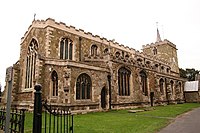Horncastle, Lincolnshire
| Horncastle | |
|---|---|
 St Mary's Church, Horncastle |
|
| Horncastle shown within Lincolnshire | |
| Area | 5.73 km2 (2.21 sq mi) |
| Population | 6,815 (Census 2011) |
| • Density | 1,189/km2 (3,080/sq mi) |
| OS grid reference | TF2669 |
| • London | 115 mi (185 km) S |
| District | |
| Shire county | |
| Region | |
| Country | England |
| Sovereign state | United Kingdom |
| Post town | HORNCASTLE |
| Postcode district | LN9 5xx & LN9 6xx |
| Dialling code | 01507 |
| Police | Lincolnshire |
| Fire | Lincolnshire |
| Ambulance | East Midlands |
| EU Parliament | East Midlands |
| UK Parliament | |
Horncastle is a market town in Lincolnshire, England, 17 miles (27 km) east of the county town of Lincoln. Horncastle had a population of 6,815 at the 2011 Census.
Although fortified, Horncastle was not on any important Roman roads, which suggests that the River Bain was the principal route of access.
Roman Horncastle has become known as Banovallum (i.e. "Wall on the River Bain") – this name has been adopted by several local businesses and by the town's secondary modern school. But, the Roman name for the settlement is not definitely known:Banovallum was suggested in the 19th century through an interpretation of the Ravenna Cosmography, a 7th century list of Roman towns and road-stations. Banovallum may have been Caistor.
The Roman walls remain in places — one section is on display in the town's library, which was built over the top of the wall. The Saxons called the town Hyrnecastre, from whence its modern name was derived.
Horncastle is listed in the 1086 Domesday Book as consisting of 41 households, including twenty-nine villagers and twelve smallholders, and had 100 acres (0 km2) of meadow and two mills, all belonging to King William.
Dating from the 13th century prior to the Reformation, the Anglican parish church is dedicated to Saint Mary. In the Early English style, it is a Grade II* listed building. It was extensively restored between 1859 and 1861 by Ewan Christian.
...
Wikipedia

